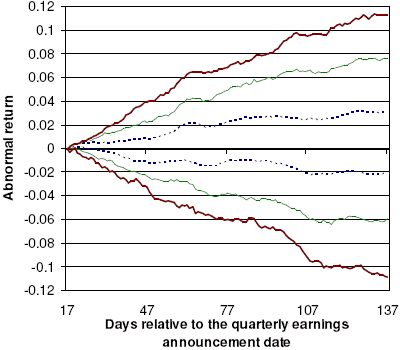Do companies systematically manage earnings in attempts to smooth out the bumps? If so, can investors detect and exploit such gaming? In their January 2008 paper entitled “Reconciling the Market’s Underreaction to Earnings Changes and Overreaction to (Abnormal) Accruals: An Earnings Management Explanation”, Henock Louis and Amy Sun investigate whether earnings management accounts for anomalous market reactions to earnings and accruals surprises. Specifically, they test whether firms with accelerating (deteriorating) earnings systematically manage earnings downward to create reserves (upward to avoid reporting losses). Using firm financial data and associated stock prices over the period 1988-2005, they conclude that:
- A hedge portfolio that is long (short) the 20% of firms with the lowest (highest) abnormal accruals generates an average return of 5.1% over the two quarters after earnings announcements.
- A hedge portfolio that is long (short) the 20% of firms with the highest (lowest) earnings changes also generates an average return of 5.1% over the two quarters after earnings announcements.
- A hedge portfolio that combines the accruals and earnings effects by going long (short) firms with the most positive earnings changes and most negative abnormal accruals (the most negative earnings changes and most positive abnormal accruals) generates an average return of 13.4% over the two quarters after earnings announcements.
- Further qualifying this combined-effect hedge portfolio such that long (short) positions are in firms most likely to smooth earnings downward (manage earnings upward) boosts average returns to 23.0% over the two quarters after earnings announcements.
- The long-side qualifier is strong operating performance.
- The short-side qualifier is declining earnings that would have resulted in a loss if not for large positive discretionary accruals.
- There is no post-earnings announcement drift for firms least likely to manage earnings.
- These abnormal returns are largely unrelated to commonly used risk factors. They relate positively to institutional holdings and negatively to trading volume.
The following chart, excerpted from the paper, depicts average cumulative size-adjusted returns during 1990-2005 for the long and short sides of most of the trading strategies noted above. It tracks average returns for 120 trading days starting 18 trading days after earnings announcements.
The dashed blue lines show the returns for long and short positions based on earnings changes. (See the second bullet above.)
The solid thin green lines show the returns for long and short positions based on the combined effects of earnings changes and abnormal accruals. (See the third bullet above.)
The solid brown lines show the returns for long and short positions based on the combined effects of earnings changes and abnormal accruals, restricted to firms mostly likely to engage in earnings management. (See the fourth bullet above.)
The regularity of cumulative returns indicates that the strategies are not sensitive to the exact portfolio start date.

The paper does not address the effect of trading costs/frictions on strategy returns.
In summary, investors may be able to generate substantial abnormal returns by combining the effects of earnings and accruals surprises, qualified by overall firm operating performance.
It would be interesting to see whether implementation of the 2002 Sarbanes-Oxley Act (SOX) affects strategy profitability.